|
Green World/Stone WorldThe Two Worlds of Joan of Arc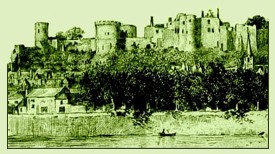
At this crossroads of history, a seventeen-year-old peasant girl arrived at Chinon Castle claiming God had sent her to lead France to victory. So desperate was the dauphin that instead of laughing at her, he arranged a test. He had her brought to a chamber where he stood unobtrusively among a crowd of more richly dressed courtiers. Undistracted by the dazzle of candlelight and glitter of gold, Joan of Arc strode toward him. "I bring you news from God," she said. "Do you set me bravely to work, and I will raise the siege of Orléans." Still Charles hesitated, but eventually he sent her to Orléans, where she led the French army to a stunning victory. 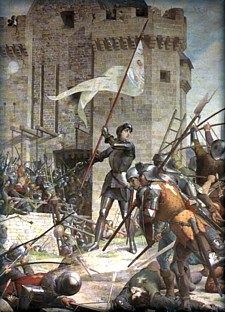
Joan's life amid the comradeship of soldiers and clash of warfare was utterly different from life in her home village of Domrémy, where she had tended sheep and milked cows. She was proud of her skill as a seamstress. "I fear no woman in Rouen at sewing and spinning," she boasted. Fifteen centuries earlier, France had been the Celtic land of Gaul, its people the ancestors of medieval French peasants like Joan. Traces of the old Celtic religion survived into her time. Near Domrémy grew a beech tree which villagers called the "Ladies' Tree" or "Fairies' Tree." They gathered May-branches there. Young people danced and sang under its canopy. "My godmother," Joan said, "even told me that she had seen fairies there, but I do not know whether it was true or not." Between the tree and the village was a spring believed to have healing properties. In Domrémy, the fourth Sunday in Lent was called "Fountains Sunday," when the villagers would eat a special meal of bread, wine and eggs under the Ladies' Tree, then stop to drink from the spring on their way home. On Ascension Day, the fortieth day after Easter, when the local priest blessed the fields, he made another stop to recite the gospel under the Ladies' Tree. Finally though, after centuries of failing to eliminate customs associated with sacred trees and wells, Christian authorities incorporated them into their world view. Even today, wells consecrated to Christian saints and Christianized Celtic deities are important features of the Celtic landscape. It was in a green and leafy place that thirteen-year-old Joan first heard a mysterious voice. "I was terrified," she said. "The voice came to me about noon; it was summer, and I was in my father's garden. I had not fasted the day before. I heard the voice on my right hand, towards the church. There was a great light all about." 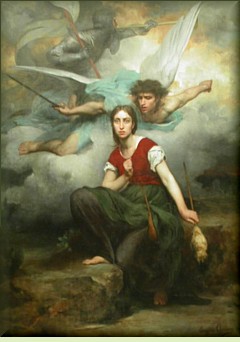
"Twice and thrice a week" she said, "the voice told me that I must depart and go into France." She came to believe the voices were those of St. Michael, St. Catherine and St. Margaret. In the spring of 1428, without telling her parents, she persuaded a relative to take her to Robert de Baudricourt, the military commander in nearby Vaucouleurs. He laughed and sent her home. But she kept returning. Her persistence and confidence finally won him over. Joan exchanged her red dress for men's clothing, which made her less conspicuous traveling with a group of soldiers. One of her escorts recalled helping provide her with a horse, as well as "a tunic and a man's suit, spurs, gaiters, a sword, and all the rest." At Chinon, the dauphin ordered her a full, custom-fitted suit of plate armor, essential protection from powerful new weapons like the crossbow. The Count of Dunois, the commander at Orléans, arranged for Joan and her soldiers to assemble on the opposite side of the river from the besieged city. After decades of defeats, the French had adopted a defensive strategy. Their troops, Dunois said, "did not seem to me, or to my lords the other captains, numerous enough to resist . . . especially as they would require boats and rafts . . . for it was necessary to go up river and the wind was exactly contrary." Joan had no patience with his caution. She scolded the captains for not taking her straight to the city. "You thought you had deceived me but it is you who have deceived yourselves, for I am bringing you better help than ever you got from any soldier or any city. It is the help of the King of Heaven." As she spoke, the wind changed. Dunois accepted it as a sign from God. The army crossed the Loire, and began the assault that would liberate Orléans. Joan's military acumen impressed the soldiers who fought under her leadership. "Except in matters of war," said one, "she was simple and innocent. But in the leading and drawing up of armies and in the conduct of war, in disposing an army for battle and haranguing the soldiers, she behaved like the most experienced captain in all the world, like one with a whole lifetime of experience." It's possible that her inexperience, along with the confidence her mysterious voices gave her, may have been among her greatest assets. It emboldened her to insist on an offensive strategy. 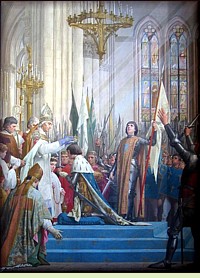
After Orléans, Joan won a string of victories leading to the liberation of Rheims and the crowning of the dauphin as King Charles VII in Rheims Cathedral on Sunday, July 17, 1429. One witness described how "the trumpets sounded so that it seemed as though the walls of the church should have crumbled." Joan believed she had achieved the mission her voices had given her, but she found it hard to set her armor and standard aside. Paris, the French capital, was still under English control. Joan and her fellow commanders itched to lead the newly heartened French troops to more victories and drive the English out of France. Instead, King Charles agreed to a truce, accepting an English pledge to surrender Paris peacefully after it ended. The English took advantage of the lull in fighting to bring in reinforcements, repair the moats and set cannons about the walls. When the truce ended they did not surrender the city. Charles realized he would have to fight to get it back. The day after he arrived in nearby St. Denis, Joan led the attack on Paris. But when a crossbow bolt struck her in the thigh, the other captains ordered a retreat against her wishes. She persuaded them to renew the attack on the following day, but before they could, King Charles ordered a retreat. That fall, he disbanded the army. Some historians think he may have been jealous of Joan's popularity and influence. She had won battles before against armies that outnumbered hers, but never at so great a disadvantage. With too few soldiers to warrant a direct assault, she instead attacked smaller forces at points surrounding the city where she might prevent reinforcements from reaching it. Soon, though, she returned to the strategy that had served her so well in the past. With typical daring and cunning, she led her troops through a gap in the city's defenses and was inside before its occupiers realized what was happening. From that position, she sallied out to attack a small force threatening the north gate. At first the battle went her way. Then enemy reinforcements arrived, and the course of the battle changed. While she covered her men's retreat, enemy soldiers surrounded her and pulled her from her horse. Sieges were common in the Middle Ages because walled castles were so effective at keeping attackers out. Now Joan learned how effective a castle could be at keeping prisoners in. Her captors locked her into a chamber in Beaulieu Castle. Battle-hardened and resourceful as ever, she tore up enough of its wooden floor one night to escape into the room below. There, she stole a key from under the sleeping guards' noses, but a patrol caught her, and she was moved to a more secure room in a tower. 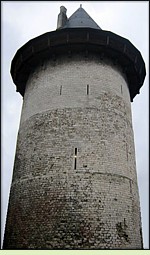
At Beaulieu, she was held by French allies of the English who might have ransomed her if the king had been willing to pay or her family had been able to raise the money. When she discovered they were about to sell her to the English, who wanted not to ransom but to destroy her, she jumped from her tower window seventy feet above the ground. Though she broke no bones, she was too bruised by the fall to complete her escape. Two days before Christmas 1430, the English took her to Rouen and locked her into a two-meter-wide hexagonal room in Bouvreuil Castle. For all her accomplishments, she was still a girl of eighteen years. They chained her to the wall by an iron band around her waist. The only light came from a single narrow window. Opposite it was a latrine she could reach only when a guard unchained her. Here she languished, badly fed, in constant physical discomfort, taunted by guards who threatened her with rape. They led her from her cell to attend a heresy trial riddled with illegalities, conducted by a biased church court controlled by the English. She defended herself with skill worthy of a theology professor, but the court declared her guilty. On May 30, 1431, Joan was burned at the stake. Much of France still lay under English occupation, but the French adopted Joan's policy of direct engagement with the enemy. In 1453 at Castillon, twenty-three years after her death, they fought and won the final battle of the Hundred Years War. Two years later, a new court in Rouen declared her heresy conviction null and void. Joan's childhood friends and companions had testified eloquently of her piety and about life in Domrémy. by Margaret Donsbach
Joan of Arc: A Military Leader by Kelly DeVries (1999) Joan of Arc: In Her Own Words compiled and translated by Willard Trask (1996) Joan: The Mysterious Life of the Heretic Who Became a Saint by Donald Spoto (2007) Joan of Arc: Her Story by Régine Pernoud and Marie Véronique Clin (1998) Joan of Arc: A Spiritual Biography by Siobhan Nash-Marshall (1999) The Retrial of Joan of Arc by Régine Pernoud (1955)
Blood Red, Sister Rose by Thomas Keneally (1974), a gritty novel about Joan of Arc from the time she began hearing voices until her capture by the Burgundians. The Life and Death of My Lord Gilles de Rais Joan of the Lilies The Burnished Blade by Lawrence Schoonover (1948), about an armourer's apprentice in France near the end of the Hundred Years War; the novel opens as he witnesses the execution of Joan of Arc. Personal Recollections of Joan of Arc, by the Sieur Louis de Conte by Mark Twain (1895; also published under the title Joan of Arc), a novel about Joan of Arc narrated by her page. Top of Page
|
 Ancient Celts believed gods and spirits dwelt in places like trees and springs. As proselytizing monks spread Christianity across Europe, they struggled to persuade people that the world around them was not sacred. In southern France, the second Council of Arles decreed in 452 that a bishop would be guilty of sacrilege if he allowed his people to "venerate trees, fountains, or stones." In 724 Saint Boniface cut down an oak sacred to the Germanic god Donar and built a church out of its wood.
Ancient Celts believed gods and spirits dwelt in places like trees and springs. As proselytizing monks spread Christianity across Europe, they struggled to persuade people that the world around them was not sacred. In southern France, the second Council of Arles decreed in 452 that a bishop would be guilty of sacrilege if he allowed his people to "venerate trees, fountains, or stones." In 724 Saint Boniface cut down an oak sacred to the Germanic god Donar and built a church out of its wood.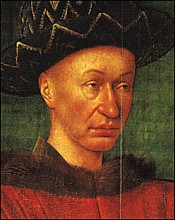 Charles rewarded Joan's service to France by ennobling her and her family. It was an extraordinary honor, but perhaps also a tactful way of indicating that he no longer wanted her to lead his army. As a member of the nobility, she now had the right to raise troops and wage war on her own, but could not raise so large an army as a king might. She gathered a small band of soldiers. Under her leadership, they freed two towns and then marched to the city of Compiègne.
Charles rewarded Joan's service to France by ennobling her and her family. It was an extraordinary honor, but perhaps also a tactful way of indicating that he no longer wanted her to lead his army. As a member of the nobility, she now had the right to raise troops and wage war on her own, but could not raise so large an army as a king might. She gathered a small band of soldiers. Under her leadership, they freed two towns and then marched to the city of Compiègne.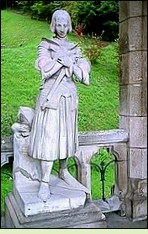 "That tree is called the Ladies' Tree," the farmer Gérardin said, "I have seen the lords and ladies of the manor of Domrémy, once or twice in spring, bring bread and wine and go and eat under that tree, which is as pretty as the lilies at that time of year, and spreads very wide. Its leaves and branches come down to the ground. On Fountains Sunday, the boys and girls of Domrémy have a custom of going under that tree. Their mothers bake them loaves, and the young people go and 'do the fountains' under that tree. They sing and dance there, and then they go to the Fontaine aux Raines, and eat their bread and drink its waters, as I have seen."
"That tree is called the Ladies' Tree," the farmer Gérardin said, "I have seen the lords and ladies of the manor of Domrémy, once or twice in spring, bring bread and wine and go and eat under that tree, which is as pretty as the lilies at that time of year, and spreads very wide. Its leaves and branches come down to the ground. On Fountains Sunday, the boys and girls of Domrémy have a custom of going under that tree. Their mothers bake them loaves, and the young people go and 'do the fountains' under that tree. They sing and dance there, and then they go to the Fontaine aux Raines, and eat their bread and drink its waters, as I have seen."